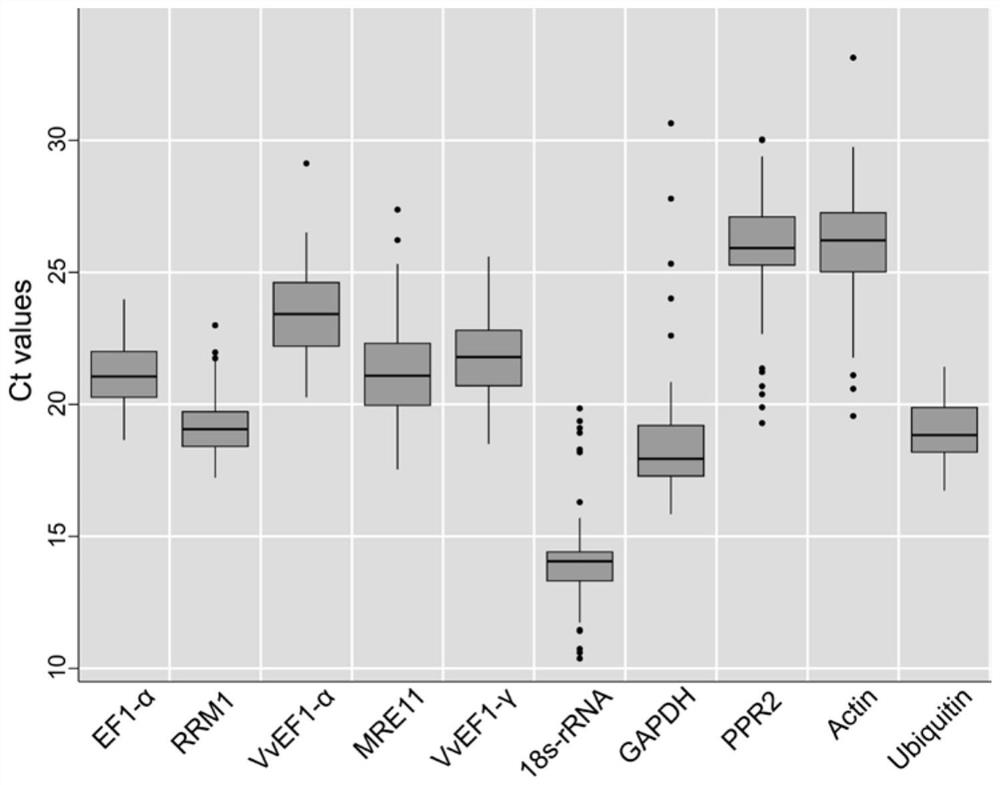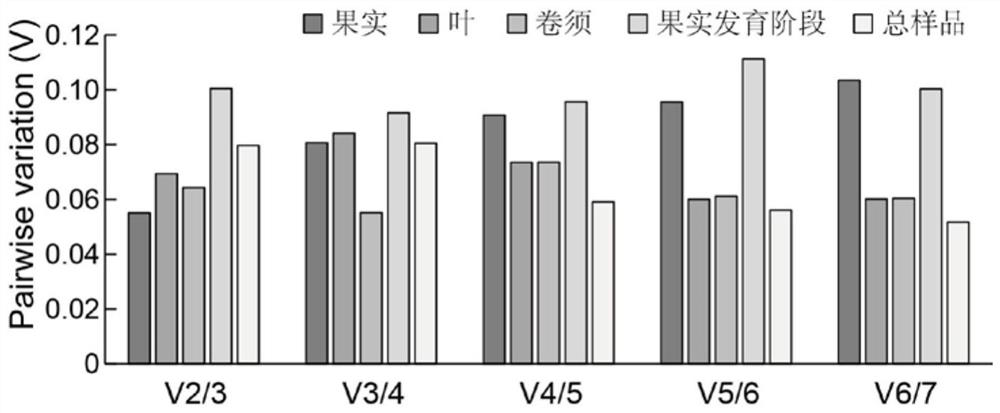QRT-PCR reference gene of grapes as well as primers and application of qRT-PCR reference gene
An internal reference gene and gene technology, applied in the field of molecular biology, can solve problems such as lack of internal reference gene research
- Summary
- Abstract
- Description
- Claims
- Application Information
AI Technical Summary
Problems solved by technology
Method used
Image
Examples
Embodiment 1
[0038] Example 1: Discovery of candidate internal reference genes
[0039] 1. Plant material and handling
[0040] In this study, the fruits, leaves and tendrils of seven grape varieties (Mauscarpa, Prickly Grape, Jingya, Beauty Finger, Zhengzhou Zaohong, Stenosaurus, Cabernet Sauvignon) and nine different developmental stages of 'Kyoho' grape were collected. Fruits and materials were collected from Zhengzhou Institute of Pomology, Chinese Academy of Sciences. The fruits of different developmental stages of 'Kyoho' and 'Fengzao' (an early-maturing bud variety of 'Kyoho') were collected at the experimental base of Henan University of Science and Technology. The five developmental stages of 'Kyoho' were collected, respectively represented by K1-K5; 'Feng Four developmental stages were collected in Zao', represented by F1-F4 respectively. Hydrogen peroxide (H 2 o 2), riboflavin and 5-azacytidine (5-azaC) were treated with ‘Kyoho’ grapes. The concentration of hydrogen peroxid...
Embodiment 2
[0043] Example 2: Design of primers for candidate internal reference genes
[0044] qRT-PCR primers were designed with Primer 5 software, and the nucleotide sequences of the primers are shown in Table 1.
[0045] Wherein, the primers for specific amplification of RRM1 gene are as follows:
[0046] F: ATGGACTCAGACGAAGGAAAGC (SEQ ID NO. 4)
[0047] R: CGAATACCACAAAAGCCAAAGC (SEQ ID NO.5)
[0048] The primers used to specifically amplify the Ubiquitin gene are as follows:
[0049] F: GTGGTATTATTGAGCCATCCTT (SEQ ID NO. 22)
[0050] R:AACCTCCAATCCAGTCATCTAC (SEQ ID NO. 23)
[0051] The primers used to specifically amplify the EF1-α gene are as follows:
[0052] F: GAACTGGGTGCTTGATAGGC (SEQ ID NO. 20)
[0053] R: AACCAAAATATCCGGAGTAAAAAGA (SEQ ID NO. 21)
[0054] Table 1. Ten candidate internal reference genes and their primer sequences
[0055]
Embodiment 3
[0056] Example 3: Stability analysis of candidate internal reference genes
[0057] 1. Total RNA extraction and cDNA synthesis
[0058] The collected samples (fruits, leaves, tendrils of grapes) were ground into powder form with liquid nitrogen. The total RNA was extracted using a polysaccharide and polyphenol total RNA extraction kit (TIANGEN, Beijing). For specific methods, refer to the instruction manual. The quality and integrity of the extracted RNA were checked by 1% agarose gel electrophoresis. Using the extracted total RNA as a template, use First-strand cDNA synthesis kit (Vazyme, Nanjing) was used to synthesize cDNA, and the specific method was referred to the instruction manual, and the synthesized cDNA was stored in a -20°C refrigerator.
[0059] 2. Real-time fluorescent quantitative PCR (qRT-PCR)
[0060] The total qRT-PCR reaction system was 10 μL, including 5 μL 2×TransStart Top Green qPCR SuperMix (Quanshi Jinbiology, Beijing), 1 μL cDNA, 0.3 μL forward an...
PUM
 Login to View More
Login to View More Abstract
Description
Claims
Application Information
 Login to View More
Login to View More - R&D
- Intellectual Property
- Life Sciences
- Materials
- Tech Scout
- Unparalleled Data Quality
- Higher Quality Content
- 60% Fewer Hallucinations
Browse by: Latest US Patents, China's latest patents, Technical Efficacy Thesaurus, Application Domain, Technology Topic, Popular Technical Reports.
© 2025 PatSnap. All rights reserved.Legal|Privacy policy|Modern Slavery Act Transparency Statement|Sitemap|About US| Contact US: help@patsnap.com



